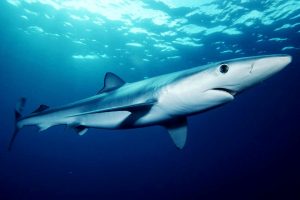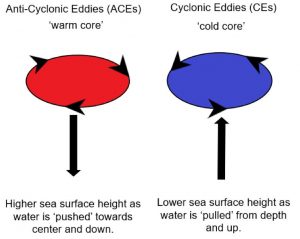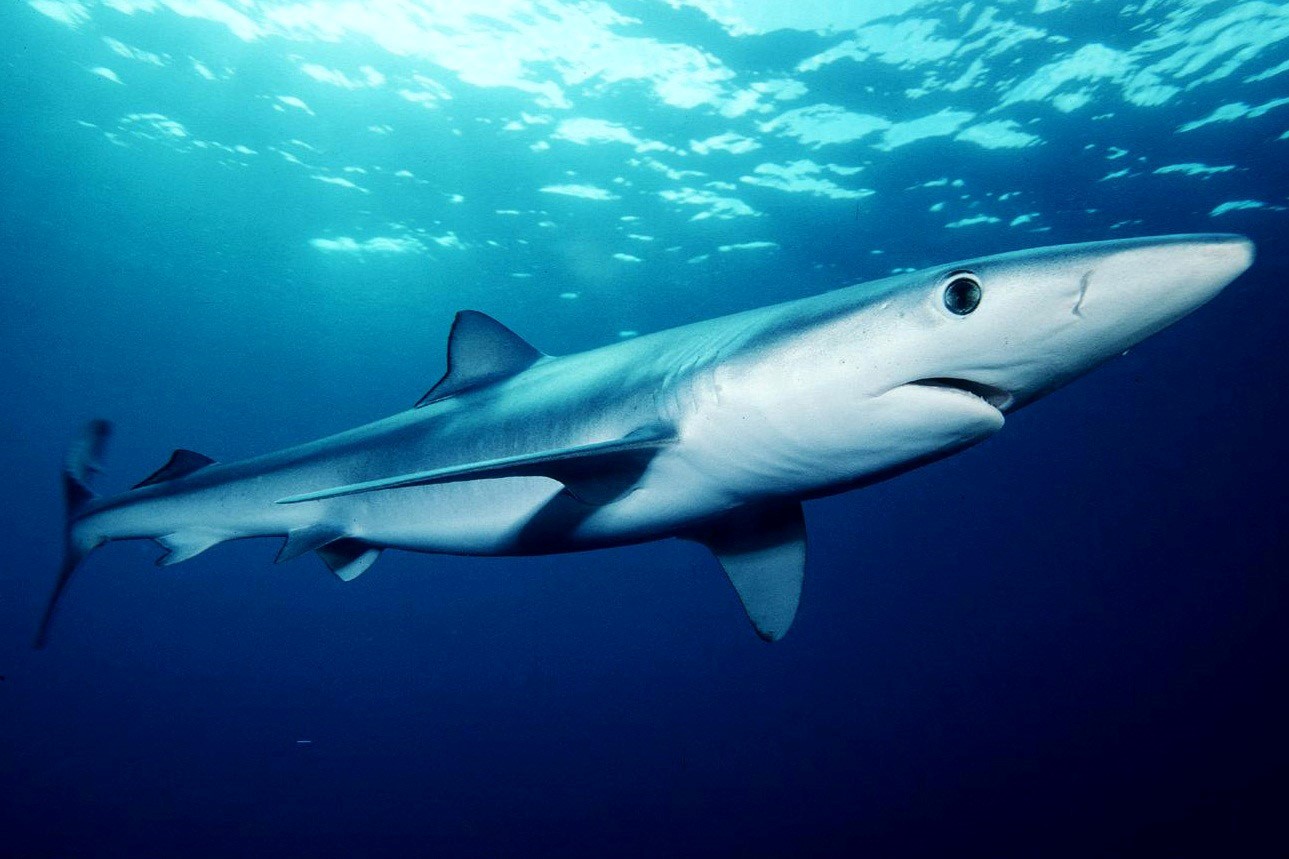Braun, C.D., Gaube, P., Sinclair-Taylor, T.H., Skomal, G.B. and Thorrold, S.R., 2019. Mesoscale eddies release pelagic sharks from thermal constraints to foraging in the ocean twilight zone. PNAS. 116 (35): 17187-17192.
https://doi.org/10.1073/pnas.1903067116

Within the world’s oceans, large circulation patterns move water from one ocean to another. Off the east coast of the U.S., the Gulf Stream plays an important role in moving water from the warmer southern waters to the New England coast. Within the Gulf Stream spinning water masses known as eddies break off transporting water towards or away from the coastline. There are two types of eddies distinguished by the direction of spinning water within each; 1) Anticyclonic eddies (ACEs) pushing warm surface waters to depth with clockwise movement and 2) Cyclonic eddies (CEs) pulling cold deep waters towards the surface with counter-clockwise movement. Previously, these warmer Anticyclonic eddies were thought to be the equivalent of ocean deserts. However, ACEs were recently found to be feeding hot-spots for one of the most heavily exploited sharks in the Atlantic Ocean.
What did the study find?

Fisheries in pelagic, or open ocean waters, provide more than 80% of fish consumed by humans but are difficult to track and regulate. Current management strategies use scientific models that predict where and when fish are most vulnerable. However, these models are generally static and do not consider changing ocean conditions and circulation. In an effort to pair these biological and physical interactions in the Atlantic Ocean, authors used a combination of satellite tags, satellite imagery, and models. Blue sharks, an important predator and one of the most heavily exploited sharks in the Atlantic Ocean, were studied. Satellite tags attached to 15 individuals recorded their location and various water properties such as temperature, salinity and depth. This information was paired with sea surface height from satellites. Sea surface height (SSH) indicates the types of eddies present at a given time—higher SSH is associated with warm water ACEs and lower sea surface height with cold water CEs. Models using all of these measurements were then created to determine if there were patterns in blue shark feeding (foraging) behavior associated with either ACEs or CEs.
Authors found blue sharks were significantly more likely to be found in the center of ACEs than CEs and were more likely to be foraging in these ACEs. Blue sharks were also found to dive for longer and deeper in these warm ACEs. In fact, even cold-water CEs originating from a warmer area in the ocean were also found to have deeper dive times associated with blue shark foraging. Both of these findings suggest temperature is an important regulator for blue shark foraging behavior with a limit of 12 °C within eddies. Because ACEs and warmer CEs have higher temperatures at depth, blue sharks are able to dive deeper for longer to look for prey in a part of the ocean they would otherwise be cut off from. These deeper ‘twilight zone’ waters contain many fish that are generally too deep for the blue shark to access. Therefore, these warmer spinning water masses (Anticyclonic eddies) provide important foraging opportunities for blue sharks.
What does this mean?
Previously, warmer clockwise spinning ACEs were considered to be ocean deserts with low production compared to colder counter-clockwise CEs. This study found ACEs provide an important feeding opportunity for the heavily exploited blue shark. Pairing physical (eddies) with biological (blue shark feeding) interactions reveals previously unknown ecologically important habitats that would otherwise be overlooked. Future ocean management strategies should consider using more dynamic models like the one used in this study to consider how changing ocean conditions affect fisheries.
I’m a PhD student in the Rynearson Lab at the University of Rhode Island (URI) Graduate School of Oceanography (GSO). My research interests are focused on human impacts on the oceanic ecosystem, particularly effects on the primary producers (phytoplankton) at the base of the food web. Currently, I work with cultures from regions of the ocean that are nutrient limited and will conduct experiments to investigate how these phytoplankton survive.


